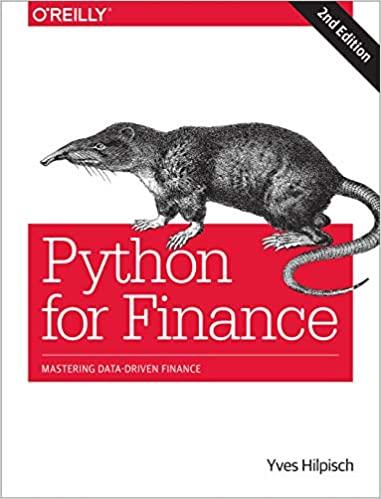Question
Your next assignment is to determine if Tesla should invest in a new car so you need to determine net cash flows and NPV and
Your next assignment is to determine if Tesla should invest in a new car so you need to determine net cash flows and NPV and determine if the project is viable or not.
Capital expenditures to produce the car will initially require an investment of $1.8 billion. Other development costs that will be required to finish the car project is $900 million this year. Any ongoing costs for upgrades will be covered in the margin calculation below. The car is expected to have a life of five years. First-year revenues for the new ride are expected to be $3,400,000,000 ($3,400 million). The ride revenues are expected to grow by 37% for the second year, and then increase by 5% for the third, decrease by 15% for the 4th and finally decrease by 25% for the 5th (final) year of operation. Your job is to determine the rest of the cash flows associated with this project. Your boss has indicated that the operating costs and net working capital requirements are similar to the rest of the companys products. Since your boss hasnt been much help, here are some tips to guide your analysis:
- You will need to use the Financial Statements that you downloaded in Part 1.
- You are now ready to determine the free cash flow. Compute the free cash flow based on the information above for each year using :
Set up the timeline and computation of the free cash flow in separate, contiguous columns for each year of the project life. Be sure to make outflows negative and inflows positive.
- Assume that the projects profitability will be similar to Teslas existing projects and estimate costs for each year of your project by using the average ratio of non-depreciation costs to revenue for the last 2 fiscal years:
Tesla calls cost of goods sold* as cost of revenues however. IMPORTANT Do not use leasing cost of revenues. This is a totally different line of business
You should assume that this ratio will hold for this project as well. You do not need to break out the individual components of operating costs in your forecast.
Simply the forecast to the Total Cost of Goods Sold (or cost of revenue) + SG&A +R&D for each year.
Determine Teslas tax rate as 1- (Income After Tax/Income Before Tax) in the last fiscal year reported. Recalculate the WACC form Part 1 using this tax rate. What should you use if this number is negative?
Calculate the net working capital required each year by assuming that the level of NWC will be a constant percentage of the projects sales. Use Teslas last 2 fiscal year average NWC/Sales to estimate the required percentage. (Use only accounts receivable, accounts payable, and inventory to measure working capital. Other components of current assets and liabilities are harder to interpret and are not necessarily reflective of the projects required NWCe.g., Teslas cash holdings.)
To determine the free cash flow, calculate the additional capital investment and the change in net working capital each year.
Determine the NPV of the project with a %5.13 WACC and the projects IRR
Dec. 31, 2019 Dec 31, 2018 $ 3,686 193 949 3,113 366 8,307 11,330 $ 6,268 246 1,324 3,552 713 12,103 10,396 1,218 339 198 393 269 808 34,309 282 68 422 398 572 29,740 Consolidated Balance Sheets - USD ($) $ in Millions Current assets Cash and cash equivalents Restricted cash Accounts receivable, net Inventory Prepaid expenses and other current assets Total current assets Property, plant and equipment, net Operating lease right-of-use assets Intangible assets, net Goodwill MyPower customer notes receivable, net of current portion Restricted cash, net of current portion Other assets Total assets Current liabilities Accounts payable Accrued liabilities and other Deferred revenue Resale value guarantees Customer deposits Current portion of debt and finance leases Total current liabilities Debt and finance leases, net of current portion Deferred revenue, net of current portion Resale value guarantees, net of current portion Other long-term liabilities Total liabilities Commitments and contingencies (Note 16) Redeemable noncontrolling interests in subsidiaries Stockholders' equity Preferred stock; $0.001 par value; 100 shares authorized; no shares issued and outstanding Common stock; $0.001 par value; 2,000 shares authorized; 181 and 173 shares issued and outstanding as of December 31, 2019 and 2018, respectively Additional paid-in capital Accumulated other comprehensive loss Accumulated deficit Total stockholders' equity Noncontrolling interests in subsidiaries Total liabilities and equity Operating Lease Vehicles (Member) Current assets Operating lease net Solar Energy Systems (Member) Current assets Solar energy systems, net 3,771 2,905 1,163 317 726 1,785 10,667 11,634 1,207 36 2,655 26,199 3,405 2,094 630 503 793 2,568 9,993 9,404 991 329 2,710 23,427 643 556 10,249 (8) 12,737 (36) (6,083) 6,618 849 34,309 (5,318) 4,923 834 29,740 2,447 2,090 $6,138 $6,271Step by Step Solution
There are 3 Steps involved in it
Step: 1

Get Instant Access to Expert-Tailored Solutions
See step-by-step solutions with expert insights and AI powered tools for academic success
Step: 2

Step: 3

Ace Your Homework with AI
Get the answers you need in no time with our AI-driven, step-by-step assistance
Get Started


